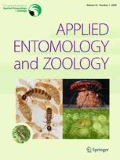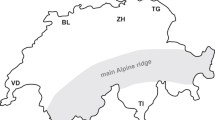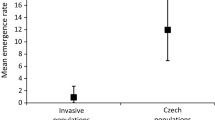Abstract
The prevalence of exotic species has a variety of effects on native biological communities. To understand the effect of exotic species on a local Drosophila–parasitoid community, I investigated associations of native and exotic frugivorous Drosophila species (Diptera: Drosophilidae) with local parasitoids in Sapporo, northern Japan. In this survey, two exotic species, D. simulans Sturtevant and D. immigrans Sturtevant, accounted for approximately 88 % of Drosophila individuals that emerged from banana bait; two native species, D. auraria Peng and D. biauraria Bock & Wheeler, accounted for approximately 10 %. Seven larval parasitoid species were recorded as emerging from Drosophila larvae occurring in banana bait; six of these were examined for host use in laboratory experiments. Drosophila simulans was favored as host by four larval parasitoids, but D. immigrans was not favored by most of the larval parasitoids. Nevertheless, more than one-third of parasitoid individuals emerged from D. immigrans in the field study, probably because of its high abundance. Thus, exotic species are assumed to affect the abundance and distributions of native parasitoid species. In this study it was not clear whether the parasitoid species mediate the effects of exotic Drosophila species on native Drosophila species, because the incidence of parasitism was usually low.
Similar content being viewed by others
References
Allemand R, Fleury F, Lemaitre C, Boulétreau M (1999) Dynamique des populations et intéractions compétitives chez deux espèces de Leptopilina, parasidoïdes de drosophiles, dans la vallée du Rhône (Hymenoptera: Figitidae). Ann Soc Entomol Fr 35:97–103
Carton Y, Boulétreau M, van Alphen JJM, van Lenteren JC (1986) The Drosophila parasitic wasps. In: Ashburner M, Carson HL, Thompson JN (eds) The genetic and biology of Drosophila, vol 3e. Academic Press, New York, pp 347–394
Collard SG (1996) Alien invaders: the continuing threat of exotic species. Franklin Watts, London
Driessen G, Hemerik L, van Alphen JJM (1990) Drosophila species, breeding in the stinkhorn (Phallus impudicus Pers.) and their larval parasitoids. Neth J Zool 40:409–427
Dubuffet A, Rodriguez-Alvarez CI, Drezen JM, van Alphen JJM, Poirié M (2006) Do parasitoid preferences for different host species match virulence? Physiol Entomol 31:170–177
Dupas S, Dubuffet A, Carton Y, Poirié M (2009) Local, geographic and phylogenetic scales of coevolution in Drosophila-parasitoid interactions. Adv Parasitol 70:281–295
Elton CS (1958) The ecology of invasions by plants and animals. Methuen, London
Fleury F, Ris N, Allemand R, Fouillet P, Carton Y, Boulétreau M (2004) Ecological and genetic interactions in Drosophila-parasitoids communities: a case study with D. melanogaster, D. simulans and their common Leptopilina parasitoids in south-eastern Fr. Genetica 120:181–194
Fleury F, Gibert P, Ris N, Allemand R (2009) Ecology and life history evolution of frugivorous Drosophila parasitoids. Adv Parasitol 70:3–44
Gilbert P, Allemand R, Henri H, Huey RB (2010) Local adaptation and evolution of parasitoid interactions in an invasive species, Drosophila subobscura. Evol Ecol Res 12:873–883
Hawkins BA (1994) Pattern and process in host–parasitoid interactions. Cambridge University Press, Cambridge
Ideo S, Watada M, Mitsui H, Kimura MT (2008) Host range of Asobara japonica (Hymenoptera: Braconidae), a larval parasitoid of drosophilid flies. Entomol Sci 11:1–6
Janssen A, Driessen G, Haan MD, Roodbol N (1988) The impact of parasitoids on natural populations of temperate woodland Drosophila. Neth J Zool 38:61–73
Kasuya N, Mitsui H, Aotsuka T, Kimura MT (2013) Diversity and host association of parasitoids attacking mycophagous drosophilids in northern and central Japan. Entomol Sci 16:227–234
Kimura MT (1987) Habitat differentiation and speciation in the Drosophila auraria species-complex (Diptera; Drosophilidae). Kontyû 55:429–436
Kimura MT, Suwito A (2012) Diversity and abundance of frugivorous drosophilids and their parasitoids in Bogor, Indonesia. J Nat Hist 46:1947–1957
Kimura MT, Suwito A (2014) What determines host acceptance and suitability in tropical Asian Drosophila parasitoids? Env Entomol 43:123–130
Kimura MT, Toda MJ, Beppu A, Watabe H (1977) Breeding sites of drosophilid flies in and near Sapporo, northern Japan, with supplementary notes of adult feeding habits. Kontyû 45:571–582
Kraaijeveld AR, Godfray HCJ (2001) Is there local adaptation in Drosophila–parasitoid interactions. Evol Ecol Res 3:107–116
Kraaijeveld AR, Godfray HCJ (2009) Evolution of host resistance and parasitoid counter-resistance. Adv Parasitol 70:257–280
Kurokawa H (1967) Population genetics of three races of Drosophila auraria Peng. III. Geographical and ecological distribution of the races, A, B, and C, with special regard to its speciation. Jpn J Genet 42:109–119
Lapchin L (2002) Host-parasitoid association and diffuse coevolution: when to be a generalist? Am Nat 160:245–254
Mitsui H, Kimura MT (2000a) Food preference of drosophilid flies in domestic and forest areas of central Japan. Entomol Sci 3:285–289
Mitsui H, Kimura MT (2000b) Coexistence of drosophilid flies: aggregation, patch size diversity and parasitism. Ecol Res 15:95–100
Mitsui H, Kimura MT (2010) Distribution, abundance and host association of two parasitoid species attacking frugivorous drosophilid larvae in central Japan. Eur J Entomol 107:535–540
Mitsui H, Van Achterberg K, Nordlander G, Kimura MT (2007) Geographical distributions and host associations of larval parasitoids of frugivorous drosophilidae in Japan. J Nat Hist 41:1731–1738
Murata Y, Ideo S, Watada M, Mitsui H, Kimura MT (2009) Genetic and physiological variation among sexual and parthenogenetic populations of Asobara japonica (Hymenoptera: Braconidae), a larval parasitoid of drosophilid flies. Eur J Entomol 106:171–178
Nordlander G (1980) Revision of the genus Leptopilina Förster, 1869, with notes on the status of some other genera (Hymenoptera, Cynipoidea, Eucolidae). Entomol Scand 11:428–453
Novković B, Mitsui H, Suwito A, Kimura MT (2011) Taxonomy and phylogeny of Leptopilina species (Hymenoptera: Cynipoidea, Figitidae) attacking frugivorous drosophilid flies in Japan, with description of three new species. Entomol Sci 14:333–346
Novković B, Oikawa A, Murata Y, Mitsui H, Kimura MT (2012) Abundance and host association of parasitoids attacking frugivorous drosophilids in Iriomote-jima, a subtropical island of Japan. Eur J Entomol 109:517–526
Parsons PA, Stanley SM (1981) Domesticated and widespread species. In: Ashuburner M, Carson HL, Thompson JN (eds) The genetic and biology of Drosophila, vol 3a. Academic Press, New York, pp 349–393
Van Lenteren JC, Isidoro N, Bin F (1998) Functional anatomy of the ovipositor clip in the parasitoid Leptopilina heterotoma (Thomson) (Hymenoptera: Eucoilidae), a structure to grip escaping host larvae. Internat J Insect Morphol Embryol 27:263–268
Vet LEM, Bakker K (1985) A comparative functional approach to the host detection behavior of parasitic wasps. II. A quantitative study on eight eucoilid species. Oikos 44:487–489
Vet LEM, Jense C, van Achterberg C, van Alphen JJM (1984) Microhabitat location and niche segregation in two sibling species of Drosophila parasitoids: Asobara tabida Nees and A. rufescens Förster (Braconidae: Alysiinae). Oecologia 61:182–188
Vincent C, Goettel MS, Lazarovits G (2007) Biological control: a global perspective: case studies from around the world. CABI, New York
Wachi N, Nomano F, Mitsui H, Kasuya N, Kimura MT (2015) Taxonomy and evolution of putative thelytokous species of Leptopilina (Hymenoptera: Figitidae) from Japan, with description of two new species. Entomol Sci 18:41–54
Watabe H (1979) Drosophila survey of Hokkaido, XXXVI. Seasonal changes in the reproductive conditions of wild and domestic species of Drosophila. J Fac Sci Hokkaido University. Ser VI (Zool) 21:365–372
Yorozuya H (2006) Effects of parasitoid on a mycophagous drosophilid community in northern Japan and an evaluation of the disproportionate parasitism hypothesis. Entomol Sci 9:13–22
Acknowledgments
I thank B. Novković, N. Kasuya, and T. Takigahira for their assistance in the course of this study. This study was partly supported by a Grant-in-Aid (no. 23370005) from the Japan Society for Promotion of Science (JSPS).
Author information
Authors and Affiliations
Corresponding author
Rights and permissions
About this article
Cite this article
Kimura, M.T. Prevalence of exotic frugivorous Drosophila species, D. simulans and D. immigrans (Diptera: Drosophilidae), and its effects on local parasitoids in Sapporo, northern Japan. Appl Entomol Zool 50, 509–515 (2015). https://doi.org/10.1007/s13355-015-0361-8
Received:
Accepted:
Published:
Issue Date:
DOI: https://doi.org/10.1007/s13355-015-0361-8




